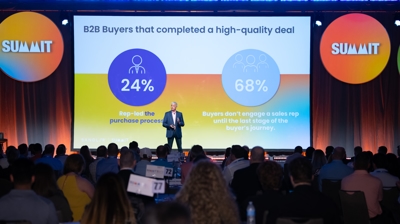Let’s be real—most sales calls go sideways before they even start.
You finally get a prospect on the phone, and within seconds:
- They hit you with, “I only have 5 minutes.”
- They sound as excited as a DMV worker on a Monday morning.
- You’re pitching too soon, they’re dodging commitment, and suddenly, you’re spiraling into discount mode.
Sound familiar?
Here’s the thing—great sales calls don’t happen by accident. They follow a structure, a rhythm, a formula that guides the prospect to a signed contract (without feeling like you’re twisting their arm).
If you haven't watched our video on How to Land Your Next Cold Call Meeting, make sure to watch that first.
Take this 5-step framework, and watch your calls go from “Maybe later” to “Where do I sign?”
Step 1: Set the Up-Front Contract (Because Prospects Hate Surprises)
If you don’t set the rules of engagement early, your call will turn into the Wild West. The Up-Front Contract (UFC) is your secret weapon to control the flow of the conversation without being pushy.
How to do it:
- Establish time (“Hey [Name], I know we booked 30 minutes—does that still work for you?”)
- Set expectations (“By the end of this, we’ll know if we’re a fit or not. Sound good?”)
- Give them an out (“If at any point you feel like this isn’t right, let me know—fair?”)
Why this works:
- Removes pressure. Prospects hate feeling trapped.
- Builds trust. They feel in control (even though you are the one steering).
- Saves you time. If they’re not a fit, you move on faster.
Pro Tip: If they try to rush you with “I only have 5 minutes,” don’t panic. Just say:
"Great! Let’s use those 5 minutes to figure out if it makes sense to keep talking. If not, no worries."
Step 2: Uncover Real Pain (Because No Pain = No Sale)
Your job isn’t to sell—it’s to find the problem. If they don’t have a big enough problem, they won’t have a big enough reason to buy.
Most salespeople ask, “So, what are you looking for?” and get a generic answer: “We just want to improve our process.” (Cool. That tells me nothing.)

Instead, dig deeper. Ask pain-focused questions like:
- “What happens if this doesn’t get fixed?”
- “How much is this problem costing you?”
- “On a scale of 1-10, how frustrated are you with your current solution?”
Why this works:
- Forces them to verbalize their pain.
- Shifts them from logic mode to emotional mode.
- Helps you position your solution as the fix.
Pro Tip: If they start giving surface-level answers, call it out: "You sound pretty calm about this—how urgent is fixing it really?"
That’s when the real pain comes out.
Step 3: Budget Talk (Because If They Can’t Afford It, What’s the Point?)
Salespeople avoid money talk like it’s a bad first date. But if you’re not qualifying budget early, you’re wasting time.
How to do it (without sounding awkward):
- “What kind of investment were you expecting for a solution like this?”
- “Most companies in your situation invest between X and Y. Is that what you had in mind?”
Common Pushback: “We don’t have a budget for this right now.”
Your response: “Totally understand. When you do make decisions like this, what kind of budget do you typically allocate?”
Why this works:
- If they say $0, you stop wasting your time.
- If they have a budget, you know what you’re working with.
- It frames cost as a normal part of the discussion.
Pro Tip: If a prospect says “We don’t know our budget yet,” that’s code for “I don’t trust you enough to tell you.” Keep digging.
Step 4: Decision Process (Because One Decision-Maker = A Red Flag 🚩)
If you’re only talking to one person, you’re in trouble.
Nothing’s worse than hearing, “This sounds great, let me run it by my team.”
How to prevent this:
- “Besides you, who else needs to be involved in this decision?”
- “How does your team typically decide on solutions like this?”
- “If we figure out this is a good fit today, what happens next?”
Why this works:
- You map out the buying process upfront.
- You avoid getting ghosted after they “talk to their boss.”
- You find out if you’re talking to the real decision-maker.
🔥 Pro Tip: If they won’t bring others into the convo, say:
"I get that—would they trust a decision made without them in the room?"
Step 5: Close With Clarity (Not “I’ll Follow Up in a Week”)
Most sales calls end in limbo. The rep says, “I’ll follow up next week,” and suddenly, the prospect vanishes into the abyss.
Instead, end with a clear next step:
- “Based on what we covered, do you feel like this is a fit?”
- “What would need to happen for us to move forward?”
- “Would it make sense to book a follow-up with [decision-makers] to go over final details?”
Why this works:
- It forces clarity.
- It removes uncertainty.
- It turns “maybe” into “yes” or “no.”
Pro Tip: If they say, “Let me think about it,” ask: "What specifically do you need to think about?"
9 times out of 10, that’s where the real objection comes out.
Time to Crush Your Sales Calls
The best sales reps don’t wing it. They follow a structure, control the conversation, and close with confidence.
Here’s your 5-step framework for every sales call:
- Set the Up-Front Contract – Control the call from the start.
- Uncover Real Pain – No pain, no sale.
- Talk Budget – Get money on the table early.
- Map the Decision Process – Find all the players.
- Close With Clarity – No wishy-washy follow-ups.
Use this, and your close rates will skyrocket.





.0000000000000.png)
.0000000000000.png)